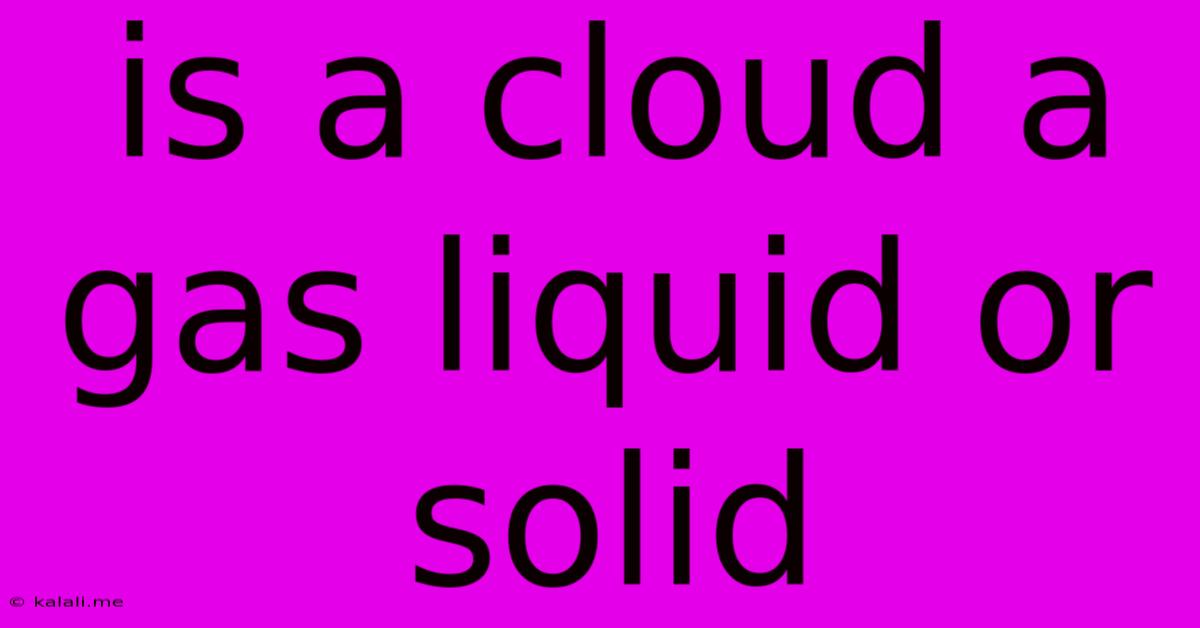Is A Cloud A Gas Liquid Or Solid
Kalali
Jun 01, 2025 · 3 min read

Table of Contents
Is a Cloud a Gas, Liquid, or Solid? Understanding Cloud Composition
Clouds, those fluffy, ever-changing formations in the sky, often spark curiosity about their composition. Many wonder: is a cloud a gas, a liquid, or a solid? The simple answer is none of the above – in a straightforward sense. A cloud is actually a massive collection of tiny water droplets or ice crystals suspended in the air. This means understanding cloud composition requires looking beyond simple states of matter. Let's delve deeper into the fascinating science behind it.
The Components of a Cloud: Water in Different Forms
Clouds aren't a singular entity but rather a vast assembly of microscopic particles. These particles, primarily water, exist in two main phases:
-
Liquid Water: In warmer atmospheric conditions, clouds are comprised mostly of tiny liquid water droplets. These droplets are so small, they remain suspended in the air due to air currents and their low terminal velocity. Think of them as miniature water balloons floating on air.
-
Ice Crystals: At higher altitudes where temperatures plummet below freezing, the water vapor transforms directly into ice crystals. These ice crystals can range in size and shape, contributing to the diverse appearances of clouds. Snowflakes are a more macroscopic example of this process.
The Role of Air and Condensation
While water is the primary component, clouds also rely heavily on the presence of air. Air acts as the medium in which these water droplets or ice crystals are suspended. The formation of clouds itself depends on a process called condensation.
Condensation is the change of water from its gaseous state (water vapor) to a liquid state. This happens when water vapor in the air cools down to its dew point – the temperature at which the air becomes saturated and can no longer hold all the water vapor. Microscopic particles in the air, called cloud condensation nuclei, act as surfaces for the water vapor to condense onto, forming the initial droplets. These nuclei can include dust, pollen, or even sea salt.
Why Clouds Aren't Simply Gas, Liquid, or Solid
The answer isn't as simple as classifying clouds as one of the three primary states of matter. Here's why:
-
Aggregate State: Clouds are more accurately described as being in an aggregate state – a massive collection of tiny particles (liquid water droplets or ice crystals) dispersed within a gaseous medium (air). This is distinct from a single, uniform substance in a solid, liquid, or gaseous state.
-
Dynamic Nature: The composition of clouds is highly dynamic. It constantly changes based on temperature, atmospheric pressure, and water vapor content. Clouds are continuously forming, changing shape, and dissipating.
-
Aerosols and other components: Clouds also contain a variety of aerosols, such as dust particles, pollutants, and other microscopic substances. These particles play a crucial role in cloud formation and properties.
In Conclusion: A Complex Mixture
In essence, a cloud is a complex mixture of tiny water droplets or ice crystals suspended in the air, a dynamic system influenced by atmospheric conditions and the presence of various particles. While water in its liquid and solid forms is the main component, categorizing a cloud simply as a gas, liquid, or solid overlooks its intricate nature and the crucial role of air in its existence. Understanding this complexity adds another layer to the appreciation of these stunning, ever-changing phenomena in our atmosphere.
Latest Posts
Latest Posts
-
What Happens When You Play A Country Song Backwards
Jun 03, 2025
-
How Long Can Cat Food Sit Out
Jun 03, 2025
-
Public Key Doesnt Match Any Of The Transaction Public Keys
Jun 03, 2025
-
How Long Does Oil Last In A Fryer
Jun 03, 2025
-
Specific Heat Of Water Vs Air
Jun 03, 2025
Related Post
Thank you for visiting our website which covers about Is A Cloud A Gas Liquid Or Solid . We hope the information provided has been useful to you. Feel free to contact us if you have any questions or need further assistance. See you next time and don't miss to bookmark.